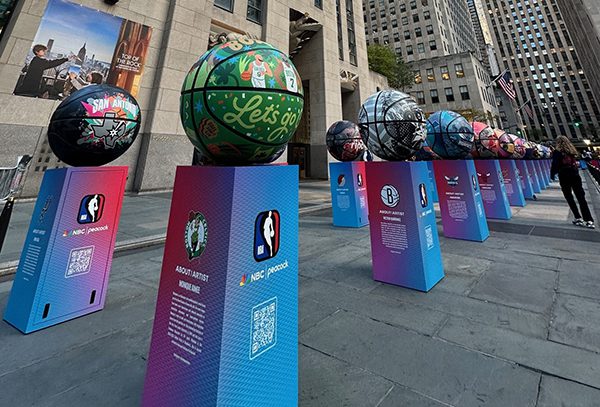Like a rebellious teen, AMP Agency is trying hard to establish its own identity. The Boston-based shop is distancing itself from sister agency 360 Youth as it pursues broader audiences, assignments beyond events and tours — and conversations with CMOs.
AMP has been quietly establishing its own reputation since parent Alloy Inc. spun it off from 360 Youth in 2001, consolidating field marketing, events, Web design and promotions at AMP and grouping media sales and menu-driven promos under 360 Youth.
Now AMP is angling for more visibility among full-service agencies, while 360 Youth pursues youth marketing and targeted media sales, repping Alloy’s online, print, on-campus and catalog properties. In fact, 360 Youth didn’t submit Promo 100 data this year despite ranking No. 3 in 2003: “It confused our positioning to have both companies recognized as promotion businesses,” says Derek White, Alloy exec VP-general manager of Media & Marketing Businesses, who oversees both shops.
Confusion lingers among some clients, who know 360’s name better than AMP’s. “We never changed agencies. They just changed their name,” says Bob Major, consumer events manager for Hewlett-Packard, which tapped AMP for its May 2002-December 2003 HP Bringing It Home Tour that showcased high-tech homes inside 18-wheelers. HP recruited a handful of the AMP retail reps that demo HP equipment in stores to staff the three tour vehicles. Major says it was that retail work, originally handled by MarketSource Corp. (which Alloy bought in 2001), that won AMP the tour business.
An identity crisis seems inevitable. Alloy built 360 Youth and AMP in a 2000-2002 buying spree that swallowed a dozen marketing companies including MarketSource, Target Marketing & Promotions and Triple Dot Communications (founded by Gary Colen, now AMP’s CEO). That complemented Alloy’s growing media empire, from its eponymous Web site and catalog to on-campus media. But the whole portfolio was unwieldy for sales reps, so Alloy divvied up the business — which also helps the shops avoid client conflicts, especially in hot segments like wireless and apparel.
Now, the two agencies and American Multicultural Marketing comprise Alloy’s Marketing & Media Group and account for about half of Alloy’s net revenues of $500 million. White says that 70% of AMP’s business targets non-teen consumers. Nearly all revenues come through marketers’ promotions budgets; 360 Youth, on the other hand, draws 60% of revenues from promotion and 40% from ad budgets.
AMP’s 2003 growth was all organic: Net revenues rose 18%, thanks mostly to current clients using more services. It’s almost all project work; Simon Property Group is AMP’s only AOR client, signed last year to handle DTour Live, a 25-mall tour with music, fashion and games for teens.
The 2003 tour ran August through October with Sprite, Delia’s, Claire’s Boutiques and TPS skateboarding magazine as sponsors. It was Simon’s five-year partnership with Coca-Cola Co. that brought Sprite on board; AMP brought in Alloy-owned Delia’s and TPS, which helped amortize Simon’s operating expenses of nearly $1 million. AMP reached kids through Alloy’s in-school media, 1 million e-mails, a student-band competition, radio station tie-ins and flyers handed out by AMP “Buzz Squads.”
“We did DTour with AMP because their media business could get us into schools,” says Simon Brand Ventures assistant VP Laurel Sibert. “They’re one of the finest execution agencies I’ve worked with — very buttoned up.”
This year, AMP brought Elle Girl, Playtex and retailer Dry Ice for an expanded DTour Live, and handles Simon’s new Mall for You women’s tour, also August through October. That 10-mall campaign invites women to “girls’ night out” activities sponsored by Self Magazine, Cotton Inc. and Diet Coke. Simon’s malls “have been an excellent venue for AMP to include in their arsenal” to create events for non-retail clients, Sibert says.
Events account for half of AMP’s business; the other half, field marketing, includes retail merchandising and consumer acquisition/activation (primarily wireless and credit cards).
This month, Verizon Wireless steps up its year-old mobile tour with six “V Teams” making 1,800 stops through yearend. AMP-staffed teams demo Verizon phones tethered to Nissan Xterras tricked out with touchscreens for info and flat screens showing ads. AMP also brings Verizon’s version of Kevin McCarthy’s Urban Challenge to 21 cities and six college campuses this spring and 14 campuses in the fall. (McCarthy approached Verizon to incorporate photo-taking phones into the rally that sends teams racing through the city to a dozen checkpoints, verifying each stop with a photo sent via phone.) The March launch stuttered when another agency was slow to sign its contract, so Verizon brought in AMP at the eleventh hour to staff the Challenge.
“They’re a joy to work with. They’re like family,” says Ann Todd, Verizon manager of events and sponsorships, who credits AMP demos for many of the 2.1 billion text messages Verizon users sent in first-quarter 2004. Separate street promos for Verizon’s regional offices please regional managers: “We get lots of feedback about how great the V Teamers are,” she says.
HP liked the way AMP routed and staffed its 2003 tour. “They did a great job scheduling events, and negotiated terrific deals at pay-to-play events,” Major says. Still, HP hired Los Angeles boutique Infinity Marketing to handle the 2004 Bringing It Home Tour “just to mix it up a little,” Major says.
AMP has handled Volkswagen of America’s Major Motion Picture Show campus tour since 2000, and ran VW’s Music Ed. Tour in fall 2002 and 2003. “We have a deep appreciation for their knowledge of the college target, and great respect for their capabilities,” says Heidi Korte, VW’s leader of promotions and product placement. Lead agency Arnold Worldwide sets strategy and creative, but AMP “has a voice in helping us decide what will resonate with students, and they come up with ideas to improve what’s not working.”
New Balance likes the way AMP handles the details of its eight-market Hoop Troop tour targeting high school and small-college basketball teams. (AMP also handles New Balance’s April-through-November corporate mobile tour.) “They know our business well and are very buttoned up on the details,” says senior marketing promotions associate Brooke Davis. Boston Market used AMP’s Buzz Squads to tout new menu items in its 650 restaurants with games and couponing in busy areas. “We had not done grassroots marketing before, and they were very proactive putting it together for us,” says director of creative services Shelly Glander. Some squads were sub-par, but it’s tough to staff consistently across the country. Since then, Alloy has opened its own temp agency, Staffing Authorities, to staff field events.
Alloy’s media is a double-edged sword for AMP. Clients get first dibs — and better access, rates and coordination, Colen says: “When opportunities come up, they go to our clients first.”
“Executives down to sales people understand we want to give preferential treatment to 360 Youth assets, but it’s about what’s best for clients,” White adds.
When AMP steers promotion clients to outside properties, Colen sometimes has to defend that to White and Alloy Chairman-CEO Matthew Diamond.
Last year AMP used Alloy media almost exclusively to launch Rite Aid’s Glam Camps, an in-store and online program targeting teen girls. Quarterly promos supported HBC and CPG brands that bought in for endcap displays, and an ongoing loyalty program offered a “Glam Bag” with goodies (including a $5 gift certificate for Alloy catalogs) and other premiums when girls collected receipts from participating brands. Rite Aid advertised the program through Alloy-owned ad boards in schools near Rite Aid stores; e-mail to girls in Alloy’s 20 million-name database; print ads in Alloy catalogs; and P-O-P and in-store radio.
Rite Aid registered 53,000 girls, but some of the Alloy media “didn’t deliver as well as we anticipated for this promotion,” Colen says. So AMP shifted to some outside media for the 2004 flight, and Colen answered for it.
“There was some colorful language, but we worked hard to keep it from being a subjective conversation,” he says. “We measure [each medium’s] performance, and if it’s not working, we change.”
Still, the media stable is a research asset for AMP, which uses online and on-campus media to conduct surveys of college students, teens and urban youth. That and twice-annual surveys via Harris Interactive feed “immersion” sessions that detail lifestyle trends for clients. A 15-member “insight team” hangs out with teens and takes notes. “We watch, listen and learn how people live their lives. It’s a tough assignment, hanging out with students during Spring Break,” Colen jokes.
Alloy’s media stable could be AMP’s foot in the door with CMOs, too. “Changing media habits, especially among youth, mean that companies have to look at their budgets and devote more to promotion,” White says. “We have the scale now to cut deals like MTV or Clear Channel.”
But clients pigeonhole agencies. “Procter & Gamble sees us as a sampling company and a promotion agency, but not officially as an event vendor,” White gripes. Plus, it’s hard to compete with promo agencies owned by ad-agency holding companies, who leverage their ad agency siblings’ broad media-buying assignments to win pitches. “That affects about half the pitches we lose,” White says. “We’re weakest at top-to-top selling. We really want to get to CMOs.”
Maybe by then people will recognize the name.
 Network
Network

